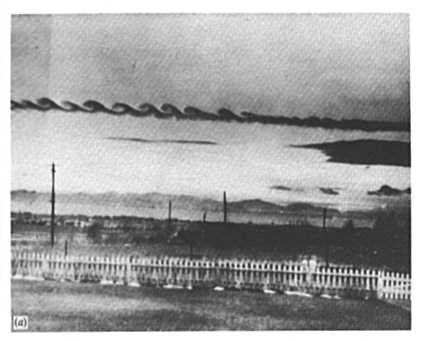 |
 |

|
 |
KELVIN-HELMHOLTZ CLOUD FORMATION
Contributed by H. Hornung
Origin unknown
A special form of instability is seen in this cloud formation.
When two streams are in parallel motion, but there is a velocity difference
between them, a shear layer forms. The shear layer is generally unstable,
in that a small perturbation, once formed, will continue to grow. The
mechanism can be explained by considering the shear layer as a thin sheet,
where the velocity changes suddenly. If the sheet develops a small bump,
say on the high-speed side, then the streamlines on the high-speed side
in the neighbourhood of the bump get closer together, and by Bernouli's
equation the pressure must decrease locally. At the same time, the streamlines
on the low-speed side get further apart, and the pressure increases. So
there is a resultant force acting on the sheet which tends to increase
the size of the bump. We see that a bump, once formed, naturally tends
to grow. That is, the shear layer is unstable. As the perturbation on
the sheet grows, it tends to roll-up, as in the picture of these clouds,
where water vapor has made the shear layer visible. This particular type
of instability is known as the Kelvin-Helmholtz instability, and it can
be seen in the initial stages of the roll-up of a shear layer. It continues
to be a feature of the structure of free shear layers, even at very high
Reynolds numbers, and it is commonly seen in many flows.
|
 |
 |
|